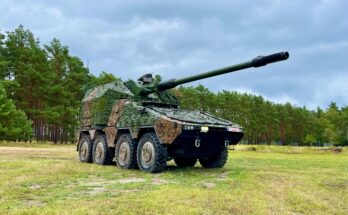Russia’s armed forces protect their mobile ICBM force with a plethora of systems tasked with electronic protection and electronic attack.
Guest post by Dr. Thomas Withington

Russian Topol-M ICBM System. Image – Russian Army
Unsurprisingly, survivability is a key tenet of Russia’s mobile intercontinental ballistic missile (ICBM) force. These truck-mounted weapons would be dispersed to Russia’s endless countryside in times of tension. By staying on the move, only stopping briefly to fire their deadly cargo, they should be difficult to find. Difficult to find means difficult to kill. These attributes are akin to those of nuclear-powered ballistic missile submarines which harness oceanic depths to preserve stealth.
The Russian military has correctly understood that the North Atlantic Treaty Organization (NATO) would strongly prioritize finding and attacking Russia’s mobile ICBM launchers in wartime. Significant resources would be dedicated to this. These would include reconnaissance satellites gathering imagery of these vehicles and their locations. Signals intelligence (SIGINT) would also play a key role in detecting and locating these assets.
Radio Armageddon
Although mobile launchers use their movements to preserve stealth, they must maintain contact with Russia’s nuclear command and control (C2) apparatus. This ensures they can send and receive information, including the all-important orders to fire their missiles.
Little information exists in the public domain on the exact nature of the communications links underpinning Russia’s nuclear C2 system. However, sources have informed the author that numerous conduits are used to share information and commands across its nuclear weapons infrastructure. These include conventional civilian and military telecommunications and fiber optics. Satellite communications (SATCOM) and high-frequency (3 MHz to 30 MHz) radio are also used. Both convey voice and data traffic beyond line-of-sight (LOS) ranges.
For Russia’s mobile ICBM force, such links are vital. Launchers would hide in remote locations like forests with thick tree canopies that can be used as camouflage in wartime. There would be little point in using conventional LOS communications when launchers may be thousands of kilometers from their commanders. Isolated rural areas are unlikely to have connections to Russia’s fixed telecommunications infrastructure. As such, the force will rely on SATCOM and HF to stay in touch. Russia’s Unified Satellite Communications System (USCS) is believed to carry traffic for conventional and nuclear forces. Russian encrypted and clear HF communications are also thought to carry nuclear C2 traffic.
It does not matter how good a radio’s low probability of detection/interception capabilities are; the second it transmits, it has a chance, no matter how small, of being detected. Once that signal is detected by a SIGINT satellite, for example, processes like triangulation can tell the radio’s location. Find the radio, and you can find the ICBM launcher. The crew may place their radio antenna some distance from the launcher, but this may offer scant protection if the launcher is targeted by a nuke. Thus, controlling a mobile ICBM unit’s radio emissions, be they SATCOM or HF, is incredibly important.
COMINT/COMJAM
The Russian military maintains electronic warfare (EW) units organic to its mobile ICBM divisions. According to the International Institute of Strategic Studies, Russia possesses three rocket armies. Each rocket army has four rocket divisions. Roger McDermott, an expert on the Russian military, says each division has an EW unit. Open sources say these units include three communications intelligence/communications jamming (COMINT/COMJAM) systems. These are reinforced with a single electronic intelligence (ELINT) and radar jamming platform.
COMINT/COMJAM systems perform two main tasks. They monitor the discretion of a mobile ICBM unit’s radio communications. They ensure the unit’s radios emit as little and as discreetly as possible. Each COMINT/COMJAM system monitors a specific part of the radio spectrum. The EW unit’s RB-341V Leer-3 monitors very/ultra high frequency (V/UHF) transmissions in wavebands of 935 MHz to 1.785 GHz. This comprises comparatively low-band SATCOM links. The MKTK-1A Dziudoist monitors frequencies of 10 kilohertz up to 18 GHz. This encompasses HF, V/UHF and high-band SATCOM. V/UHF monitoring is also the preserve of the RP-377LA Lorandit system.
However, emissions control (EMCOM) to help protect mobile ICBM units is not the only task of these mobile EW assets. The Russian armed forces are fully cognizant that NATO will have to use V/UHF and HF links to share information between aircraft when targeting launchers. As they are mobile, it is unlikely the launchers would be attacked by ICBMs or their submarine-launched ballistic missile counterparts. Such weapons are most effective against fixed targets.
Instead, mobile launchers are more likely to be targeted by conventional- or nuclear-armed combat aircraft. These can receive updates during their sorties on the locations of these launchers across NATO communications like the Link 16 tactical datalink. Link 16 uses UHF frequencies of 960 MHz to 1.215 GHz. If the Leer-3 and Lorandit can detect and jam Link 16 transmissions, they may impede NATO aircraft from targeting these launchers. Moreover, by detecting the transmissions, it may be possible to determine the location of the aircraft making them. Such information could prove useful to Russian air defenders. These EW systems could also hold NATO HF and SATCOM links used to help target these launchers at risk.
Radar Raiders
The mobile ICBM force does not only use its collocated EW units for COMINT/COMJAM. The units’ IRL257E Krasukha-4S systems can detect and jam radar transmissions in 8 to 10 GHz wavebands. This serves two purposes: Combat aircraft fire control radars transmit in X-band (8.5 GHz to 10.68 GHz). Jamming these radars could frustrate the ability of NATO combat aircraft to locate and target these launchers. A useful extra attribute is that the International Telecommunications Union, which regulates global use of the radio spectrum, reserves part of X-band for exclusive military SATCOM use. Thus, the Krasukha-4S may be able to attack NATO X-band SATCOM links which may share targeting information.
The Russian armed forces clearly take the electronic protection of its mobile ICBM units seriously. However, the capabilities of some of these systems, which also support Russia’s war in Ukraine, are debatable. This raises questions regarding the extent to which they can protect the ICBM force.
Russian Mobile ICBM Force EW Capabilities
| System | Role | Frequencies Targeted | Possible Range Against Airborne Targets |
| RB-341V Leer-3 |
COMINT/COMJAM | 935 MHz to 1.785 GHz | 162 nautical miles/nm (300 kilometers/km) |
| MKTK-1A Dziudoist | COMINT/COMJAM | 10 KHz to 18 GHz | Unknown |
| RP-377LA Lorandit | COMINT/COMJAM | 3 MHz to 3 GHz | Unknown |
| IRL257E Krasukha-4S | ELINT/Radar Jamming | 8 to 10 GHz | 22 nm (40 km) |
Dr. Thomas Withington is an award-winning analyst and writer specialising in electronic warfare, radar and military communications. He has written widely on these subjects for a range of specialist and general publications. He also works as a consultant and adviser in these areas for several leading government and private sector clients. Furthermore, Dr. Withington provides regular commentary on security and defence aspects of electromagnetic spectrum use for major media organisations around the world. @tomwithington
For 50 years, Forecast International intelligence reports have been the aerospace and defense industry standard for accurate research, analysis, and projections. Our experienced analysts compile, evaluate, and present accurate data for decision makers. FI's market research reports offer concise analysis of individual programs and identify market opportunities. Each report includes a program overview, detailed statistics, recent developments and a competitive analysis, culminating in production forecasts spanning 10 or 15 years. Let our market intelligence reports be a key part of reducing uncertainties and mastering your specific market and its growth potential. Find out more at www.forecastinternational.com



